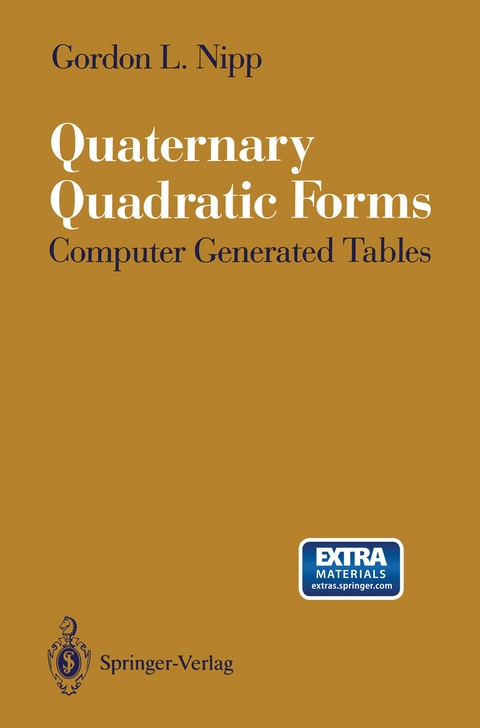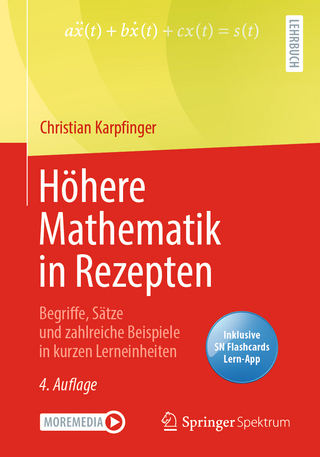
Quaternary Quadratic Forms
Springer-Verlag New York Inc.
978-0-387-97601-3 (ISBN)
This book of tables includes a reduced representative of each class of. integral positive definite primitive quaternary quadratic forms through discriminant 1732. The classes are grouped into genera; also included are Hasse symbols, the number of automorphs and the level of each such form, and the mass of each genus. An appendix lists p-adic densities and p-adic Jordan splittings for each genus in the tables for p = 2 and for each odd prime p dividing the discriminant. The book is divided into several sections. The first, an introductory section, contains background material, an explanation of the techniques used to generate the information contained in the tables, a description of the format of the tables, some instructions for computer use, examples, and references. The next section contains a printed version of the tables through discriminant 500, included to allow the reader to peruse at least this much without the inconvenience of making his/her own hard copy via the computer. Because of their special interest, we include tables of discriminants 729 and 1729 at the end of this section. Limitations of space preclude publication of more than this in printed form. A printed appendix through discriminant 500 and for discriminants 729 and 1729 follows. The complete tables and appendix through discriminant 1732 are compressed onto the accompanying 3.5 inch disk, formatted for use in a PC-compatible computer and ready for research use particularly when uploaded to a mainframe. Documentation is included in the Introduction.
1. Background.- 2. Definitions and Format.- 3. Separation into Classes.- 4. Separation into Genera.- 5. Mass Computations.- 6. Remarks.- References.- Tables of Reduced Positive Integral Quaternary Quadratic Forms with Discriminants Through 500 and of Discriminants 729 and 1729.- Appendix to Tables Through Discriminant 500, 728, and 1729.- Forms Through Discriminant 1732 (disk version).- 1. D457.EXE (d=4 through 457).- 2. D641.EXE (d=460 through 641).- 3. D777.EXE (d=644 through 777).- 4. D893.EXE (d=780 through 893).- 5. D992.EXE (d=896 through 992).- 6. D1080.EXE (d=993 through 1080).- 7. D1161.EXE (d=1081 through 1161).- 8. D1236.EXE (d=1164 through 1236).- 9. D1308.EXE (d=1237 through 1308).- 10. D1373.EXE (d=1309 through 1373).- 11. D1433.EXE (d=1376 through 1433).- 12. D1492.EXE (d=1436 through 1492).- 13. D1549.EXE (d=1493 through 1549).- 14. D1604.EXE (d=1552 through 1604).- 15. D1656.EXE (d=1605 through 1656).- 16. D1705.EXE (d=1657 through 1705).- 17. D1732.EXE (d=1708 through 1732).- 18. APP1080.EXE (Appendix, d=4 through 1080).- 19. APP1732.EXE (Appendix, d=1081 through 1732).
| Erscheint lt. Verlag | 7.8.1991 |
|---|---|
| Zusatzinfo | VII, 155 p. |
| Verlagsort | New York, NY |
| Sprache | englisch |
| Maße | 155 x 235 mm |
| Themenwelt | Mathematik / Informatik ► Mathematik ► Algebra |
| Mathematik / Informatik ► Mathematik ► Arithmetik / Zahlentheorie | |
| Mathematik / Informatik ► Mathematik ► Wahrscheinlichkeit / Kombinatorik | |
| ISBN-10 | 0-387-97601-9 / 0387976019 |
| ISBN-13 | 978-0-387-97601-3 / 9780387976013 |
| Zustand | Neuware |
| Informationen gemäß Produktsicherheitsverordnung (GPSR) | |
| Haben Sie eine Frage zum Produkt? |
aus dem Bereich


